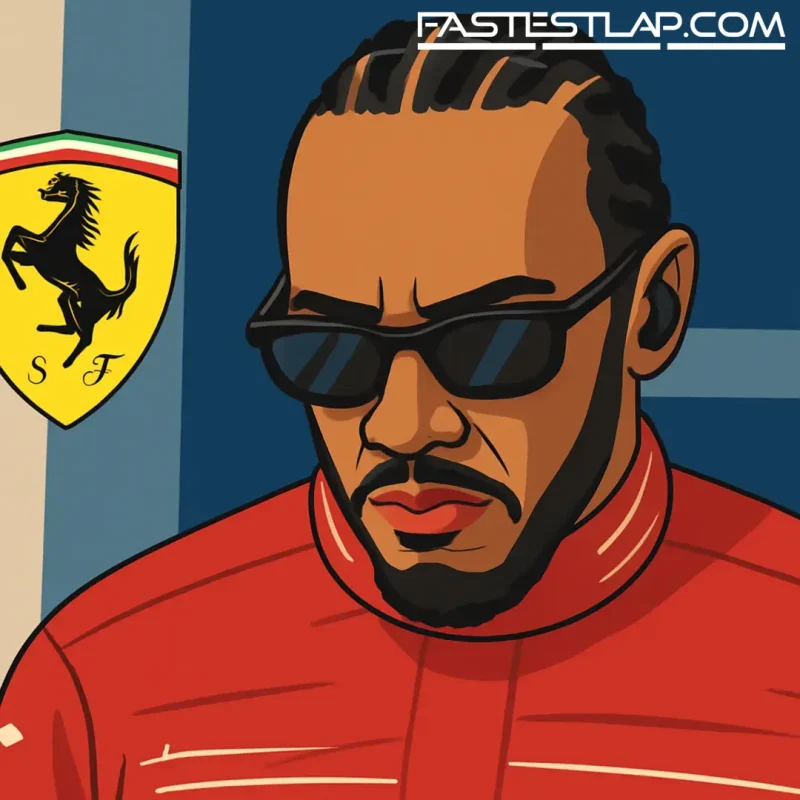Hamilton left waiting as Ferrari shuts development door on SF-25
Lewis Hamilton’s first year in red was never going to be simple. But as the season winds into its final stretch, it’s now brutally clear: the Ferrari SF-25 you see is the SF-25 you’re getting. No late-season upgrade, no magic floor, no silver (or scarlet) bullet.
“I’d give anything for an upgrade,” Hamilton admitted after P8 in Baku. He won’t get one. Ferrari’s turned the lights out on 2025 development and is already deep into 2026, where the sport’s rulebook is being torn up and rewritten.
There’s logic to Maranello’s call — and risk. The 2026 car will be smaller and roughly 30 kilograms lighter under the FIA’s “nimble” concept, with narrower Pirellis and no DRS, replaced by active aero front and rear. Power units will carry much more electrical muscle and run fully sustainable fuel. It’s a reset big enough to tempt any top team to stack chips early. But it leaves Hamilton trying to wring confidence and points out of a package that’s frozen in place.
On paper, he’s improved since the summer break. In reality, Ferrari as a whole has sagged. Charles Leclerc’s fourth place at Monza stands as the high-water mark since the shutdown; Hamilton hasn’t finished higher than sixth in that span. In Baku he was blunt: qualify better and there’s a race to be had; qualify where they have been, and you wind up in a strategic cul-de-sac. Clean laps on Saturday are the only lever left to pull.
It’s not the debut arc he or Ferrari envisaged. Leclerc has banked five podiums this year. Hamilton, still hunting his first in red, insists a top-three “would be nice” but wouldn’t change much. That’s either stoicism or a hard read on where the SF-25 sits as the development race moves on without it.
The Singapore Grand Prix could’ve been a Hamilton weekend in other eras. He’s won there four times and delivered one of the all-time qualifying laps at Marina Bay in 2018. This time around? “Not much,” he said when asked what he’s expecting. If it rains, he added, at least it’ll be interesting. That’s not defeatism; that’s a driver who knows where his car’s ceiling is on a street circuit that punishes understeer and oversteer with equal cruelty.
Ferrari’s calculation is simple enough. With seven rounds to go, Hamilton sits sixth in the standings, 44 points back from Leclerc. There are still opportunities if they execute perfectly on Saturdays and stay out of trouble on Sundays, but the championship math isn’t the point anymore. The point is 2026 — active aero maps, hybrid deployment strategies, and the small matter of designing a car that races well without DRS in anyone’s dirty air.
And that’s where Hamilton’s comments matter. When he talks about “optimising and execution,” it reads like a holding pattern. It’s also a hint. The most valuable work he can do in the meantime is feed the factory real-world answers: how the SF-25 behaves in traffic, how it uses its tyres over awkward stints, where the balance falls apart on bumpy braking zones. That information migrates. The 2026 Ferrari won’t be an evolution, but the people building it are the same, and the dialogue between cockpit and CAD station is what Ferrari is really prioritising now.
None of which softens the optics. Hamilton didn’t come to Ferrari to run P6-P8 while the upgrades stop arriving. But he also didn’t come for the short-term fix. His move was always about the next regulations and the chance to spearhead that project with the kind of experience no one else on the grid can fake. In the meantime, it’s elbows-out Saturdays, tidy Sundays, and the occasional wish for rain.
If Ferrari sticks the landing in 2026, this autumn will read like the sensible preamble before the main act. If not, it’ll feel like a missed chance to give a seven-time champion a little more to play with in year one. For now, Hamilton knows the brief. Qualify better. Execute cleaner. Squeeze everything from a car that’s in its final form — and make sure the next one isn’t.




